Long forgotten, the vegetable purslane is gaining popularity again. You can find out here how to grow and care for purslane in your own garden.
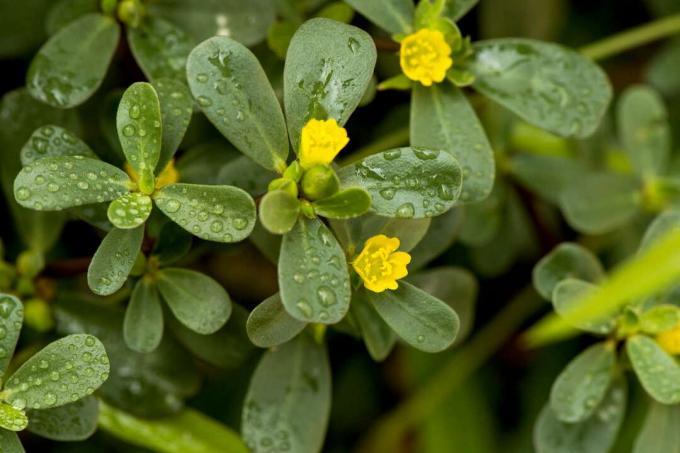
Purslane (Portulaca oleracea) is the new local superfood: It grows quickly, provides delicious leaves all summer long, is robust and easy to care for and is full of good ingredients such as vitamin C, omega-3 fatty acids and Minerals. So if you don't want to do without the delicious leafy vegetables, it is high time to grow purslane yourself in the garden. Our article tells you what you need to know about the vegetable purslane. We'll tell you everything about the origin, different types and varieties, cultivation, care and harvesting of purslane.
The purslane belongs to the purslane family (Portulacaceae). It is also called vegetable purslane, summer purslane or, popularly, rumpwort. It is unclear where the name of the plant comes from. So the origin could perhaps be in the Latin words
porcus (Pig) or porcellus (Piglet) lying - so it would be, literally, a “pig's cabbage”. Another possibility would be the Latin words portula (Wicket) or porta (Door, gate) as namesake for Portulaca oleracea.With Postelein (Claytonia perfoliata), the so-called winter purslane from the spring herb family (Montiaceae), the summer purslane has little to do. The two leafy plants are often confused because they look similar and are used in the same way. The purslane can be harvested between May and September and the juicy leaves and fleshy stems can be used as vegetables and herbs. The buds of the plant were also used as a substitute for Capers used.
The wild form of purslane has meanwhile been decried as a weed, in Spain whole fields are covered with the undesirable weeds. Cultivated or as a wild herb, however, purslane is a wonderful vegetable that will provide you with fresh, crisp leaves throughout the summer. These taste nutty and sour, a bit salty and can be enjoyed in a salad, in green smoothies or cooked like spinach. Plus, they're full of good ingredients like vitamin C, minerals, and omega-3 fatty acids.
contents
- Origin and characteristics of purslane
-
Species and varieties of purslane
- Which purslane species and varieties are recommended?
- Portulaca grandiflora: Purslane florets
- Buy purslane
-
Growing purslane
- The right location for growing purslane
- How to grow purslane
- Caring for purslane: Proper watering and fertilizing
- Propagate purslane
- Harvest and store purslane
- Ingredients and uses of purslane
Origin and characteristics of purslane
The vegetable purslane originally comes from Africa and Asia Minor. Already around 800 BC the plant was mentioned in Babylonian writings as a medicinal plant and cultivated in the medicinal herb garden of the Babylonian king. The ancient Greeks used it as a vegetable and also as a cure for constipation and inflammation. Hildegard von Bingen also appreciated purslane as a medicinal herb. In the Middle Ages, purslane was grown in many monastery gardens in order to use it as an important source of vitamin C for combating scurvy. In other parts of the world, such as India, purslane has also long been valued as a delicious vegetable. We had long forgotten the plant and only recently gained more attention and use in domestic kitchens and restaurants.
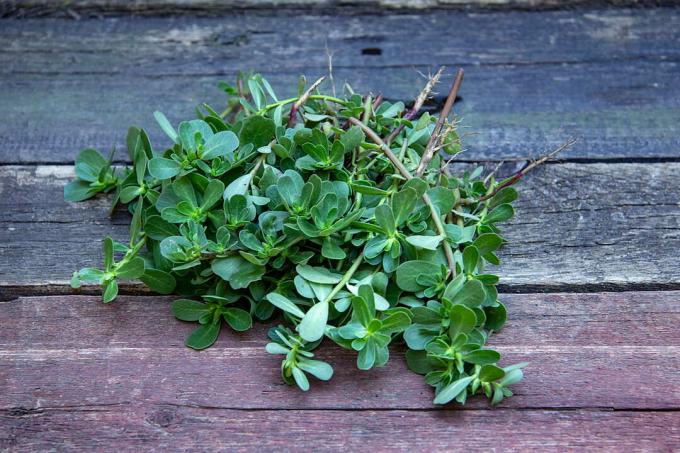
Purslane is an annual herbaceous and succulent plant. It can reach heights of growth of up to 40 centimeters. The creeping plant spreads quickly and can easily cover a quarter of a square meter of soil. As a leaf succulent, the purslane has thick, fleshy leaves and stems. The stems have a diameter of about five millimeters, are green and can sometimes be reddish in color. The leaves are yellow-green or green and up to 3 inches long, 1.5 inches wide and spatulate. From May to October, small yellowish or white flowers appear on the leaf axils or at the tip of the shoots. A plant can produce up to 10,000 seeds that can remain viable in the soil for up to 100 years.
Species and varieties of purslane
There are different types and varieties of purslane around the world. We have put together the most interesting ones for you here.
Which purslane species and varieties are recommended?
Summer purslane (Portulaca oleracea) is the classic purslane. In the following, we will introduce you to some varieties of the popular leafy vegetable.
- "Kuzminsky Semko": This variety makes light green leaves and small yellow flowers. It is fast-growing and quickly produces a lot of leaf mass. On the other hand, this variety does not tolerate cold at all and dies with the slightest frost.
- paradox: The leaves of this variety are particularly thick and fleshy. It also ripens very quickly; You can harvest the first leaves around 25 days after sowing.
- "Macovei": This variety also impresses with its vigor and crisp, green leaves.
- ˈFireflyˈ: This variety of purslane can reach heights of up to 50 centimeters and produces a very rich harvest. The leaves have a rather sour taste.
Wild purslane (Portulaca oleracea): The wild form of purslane is particularly easy to care for and grows quickly. The wild purslane has smaller leaves than the cultivated form. It reproduces by itself and can quickly become a nuisance in the garden.
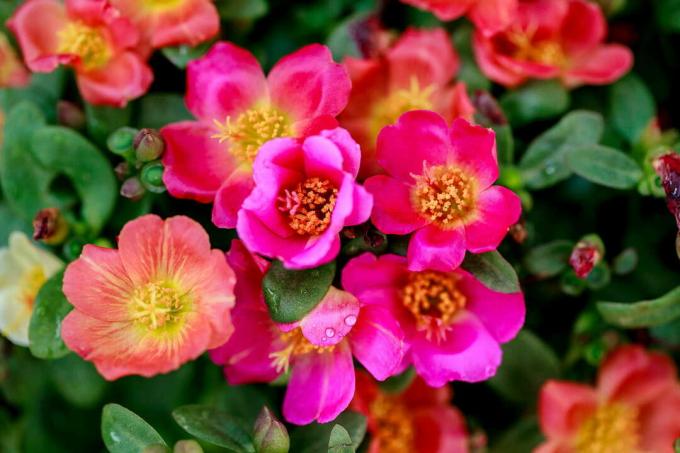
Portulaca grandiflora: Purslane florets
The purslane rose (Portulaca grandiflora) is a beautiful flower that blooms in bright, bright colors on the bed, balcony or terrace. She likes it warm and sunny and can be grown both in the garden and in the pot. The flowers and leaves of are edible Portulaca grandiflora though not.
Everything you want about the beautiful Purslane florets need to know, you can find out in our special article on the subject.
Buy purslane
Purslane is actually only available as seed, you will hardly be able to find young plants in stores. But that's not bad at all, as the summer purslane is easy to sow yourself and grows quickly. When buying, you should pay attention to the choice of the right type and variety as well as the shelf life of the seeds. In spring you can find purslane seeds in nurseries, garden centers or at the weekly market. You can also order seeds online, for example from specialized seed breeders such as Flail or Rühlemann‘s.
More about the Buying purslane can be read here.
Growing purslane
Both the right location in the garden and the right approach to sowing are important for growing purslane. In the following, you will therefore learn everything about the professional cultivation of purslane in your own garden.
The right location for growing purslane
The summer purslane likes it sunny and warm. The soil for the leafy vegetables should be loose and well drained. Sandy soils that are not too moist are ideal.
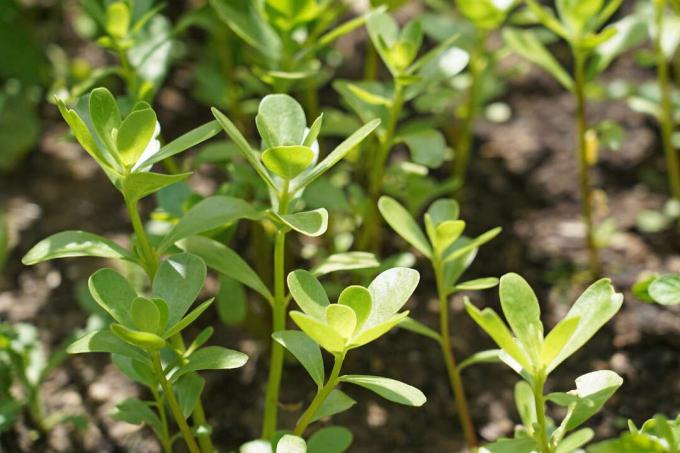
Tip: Purslane is an excellent companion plant. It provides nutrients and moisture for neighboring plants and "guides" their roots into deeper parts of the soil. Good neighbors for purslane, for example Strawberries (Fragaria), Kohlrabi (Brassica oleracea var. gongylodes) or also radish (Raphanus sativus var. sativus).
What is the right location and soil for purslane?
- Sunny
- Warm
- Loose, well-drained soil
- Sand is ideal
- Definitely not too damp
How to grow purslane
As the name suggests, summer purslane is grown in summer. The vegetables can germinate at temperatures between 20 and 22 ° C. That is why sowing is not recommended until mid-May. You can also prefer the plants in the pot, if you want. Since purslane germinates and grows very quickly, this is not really necessary. Purslane can be grown in pots just as well as in the garden bed.
Prepare the bed for sowing by loosening the soil well and adding sand to heavy soils. Your purslane will be all the more happy if you provide the soil with extra nutrients in the form of compost or a fertilizer with long-term organic effects - like ours Plantura organic universal fertilizer - enrich. It will grow even better after sowing. Broad sowing seeds directly on the bed is best for purslane. Since it is a Light germs the seeds should only be covered minimally with soil. The purslane germinates after only five to ten days. As soon as two cotyledons have formed on the seedlings, you can isolate the plants to a distance of 15 by 15 centimeters between the plants.
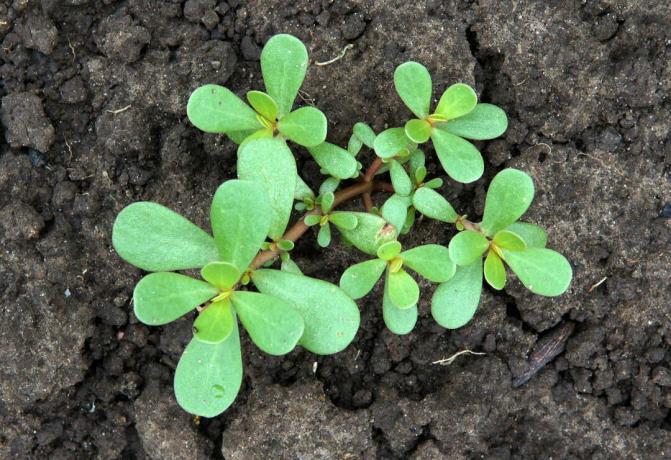
How do you grow purslane?
- Sow directly into the bed from mid-May
- Advance possible, but not necessary
- Loosen up the bed and add sand to the heavy soil
- Work compost or a fertilizer with organic long-term effects into the soil
- Broad sowing seeds in the bed
- Cover the seeds very lightly with soil
- Pouring on
- Germination time: 5 - 10 days
- Isolate at the dicotyledon stage
- Plant spacing: 15 x 15 cm
Caring for purslane: Proper watering and fertilizing
Purslane is frugal and undemanding and therefore a pleasant guest in the garden bed. In addition, it is insensitive to diseases and pests and does little work in the garden. As a succulent plant, the leafy vegetables can cope with drought and can withstand longer periods of drought. Too much water, on the other hand, is very harmful. Do not overdo it with watering, but only water on particularly hot and dry days. If you have already supplied your purslane with compost or a fertilizer with organic long-term effects while planting, it does not need any further fertilization. Our Plantura Organic universal fertilizer comes in practical granulate form and dissolves after pouring. The nutrients from the fertilizer are then broken down microbially and made available to the plants. This is particularly gentle on the plant, the animals in the soil, your garden and the environment.
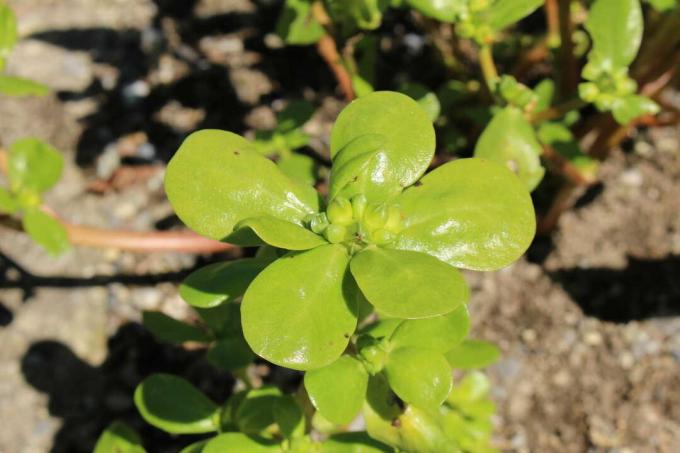
How is purslane properly cared for?
- Don't pour too much
- Only give water on particularly hot and dry days
- Basic fertilization with compost or a fertilizer with organic long-term effects before planting
- Thereafter, no further fertilization is necessary
Propagate purslane
Purslane is not hardy and therefore dies in frost. Therefore, theoretically, it has to be re-sown every year. In practice, however, it looks like the plant will reliably sow itself. This can even become a problem if the vigorous purslane spreads further and further in your garden and also grows where you don't want it at all. If you only need a small amount of purslane anyway, growing it in a 10 to 15 centimeter pot is sufficient. This will give you enough purslane to harvest and there is less of a risk of the leafy vegetables spreading wildly in your garden.
If you want to sow your purslane in a new spot in the garden, you can collect the seeds of the plant. Just six weeks after flowering, the small, black seeds of the purslane are mature and can be collected. In a dry, dark and cool place, the seeds will keep until the next year.
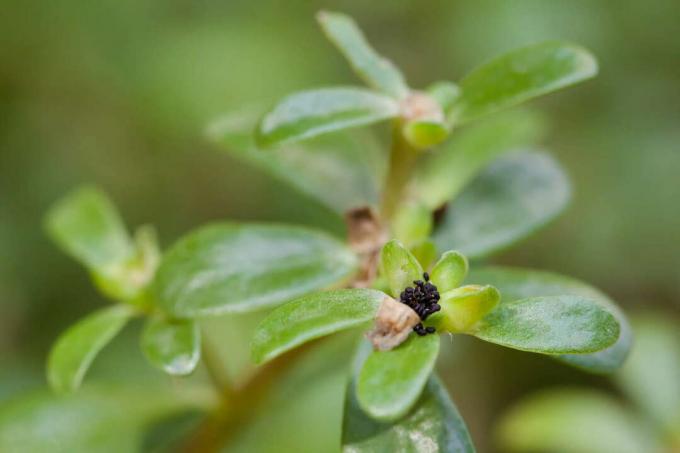
How is purslane propagated successfully?
- Propagation through reliable self-sowing
- Seed extraction possible
- Let plants bloom
- After 6 weeks, small, black seeds will form
- Store seeds in a dark, cool and dry place
- Seeds can be kept for one year
Harvest and store purslane
The great thing about purslane is that it is quickly ripe for picking and can be harvested all summer. You can pick the first tender purslane leaves just four to six weeks after sowing. As soon as the first flowers appear, the taste of the leaves becomes increasingly bitter. Therefore, always harvest the leaves with the stem. Cut the stems two fingers' breadth above the ground. This is how the purslane grows back reliably.
Once harvested, purslane can unfortunately not be stored for very long. It is best to wrap it in a damp tea towel and store it in the vegetable compartment of the refrigerator. So it can be kept for up to five days. Preserving fresh purslane is rather difficult. When frozen, the leaves quickly become mushy. One option is to cook the leaves like spinach and then freeze them, or to pickle the raw leaves in vinegar. Note, however, that the vegetables lose many of their nutrients when they are cooked.
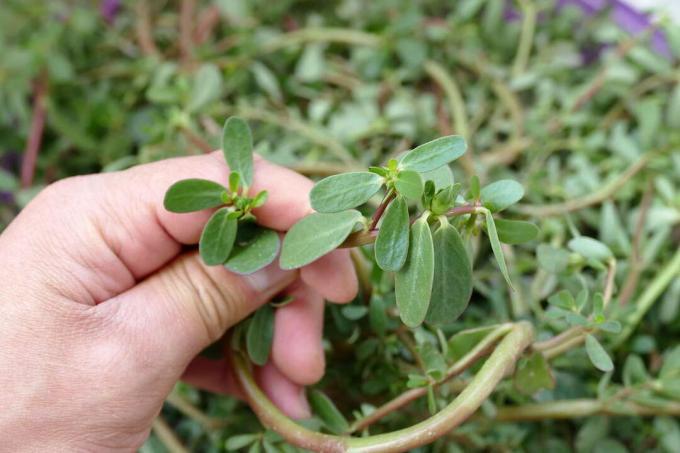
Summary harvesting and storing purslane:
- First harvest 4 - 6 weeks after sowing
- Purslane can be harvested all summer
- Cut whole stems two fingers' breadth above the ground
- As soon as flowers form, the leaves turn bitter
- Storage for a maximum of 5 days in the refrigerator
Ingredients and uses of purslane
The fact that purslane has been gaining popularity again recently has to do with its valuable ingredients. The leaves and stems of the plant contain, among other things, vitamin C, potassium, calcium, magnesium, folic acid and important omega-3 fatty acids. Since the edible parts of the plant consist of 92 percent water, the purslane is also extremely low in calories. As a medicinal plant, purslane is said to have blood-purifying, anti-inflammatory, refreshing and diuretic effects.
With its refreshing, nutty and salty taste, which can also be slightly sour at times, purslane is wonderfully suited raw as a salad. But it can also be used in other versatile ways. The chopped leaves can be used as a spice for various dishes, the raw leaves and stems are great for making green smoothies or juices. Briefly blanched, purslane is a nice vegetable on the plate. Cooked with cream, it is just as delicious as creamed spinach.
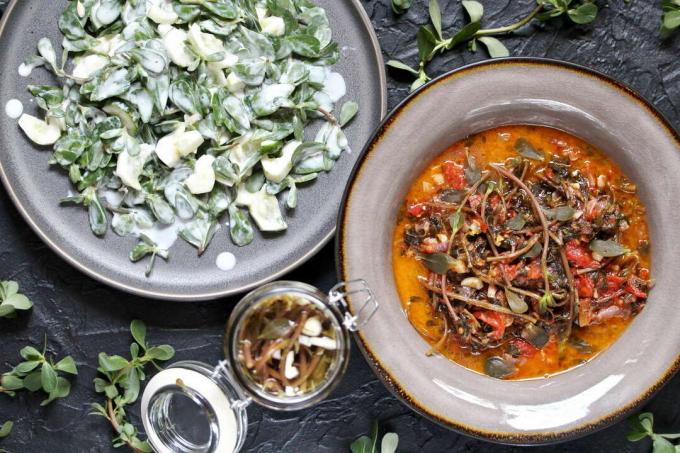
The Dutch purslane is also a popular method of preparation: To do this, young purslane leaves are scalded with boiling water and then finely chopped. Then the leaves are steamed in butter, refined with salt and pepper and finally tied with egg yolk and flour butter. Other ways to use purslane in the kitchen are in herbal quark, as herb butter or in soups. The taste of the flower buds is reminiscent of capers and can be used like such.
